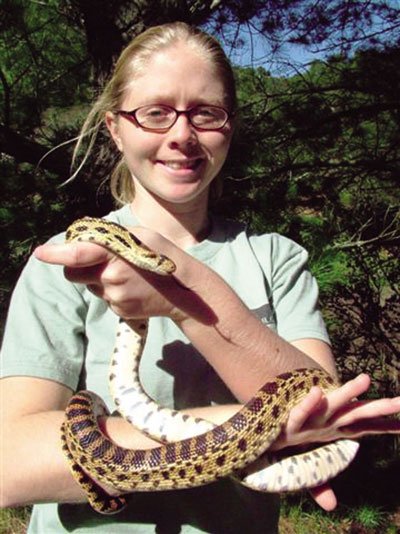Though snakes on a plane may be quite detrimental, snakes in a
lawn are your garden’s best friend.
Though snakes on a plane may be quite detrimental, snakes in a lawn are your garden’s best friend.
Snakes admittedly have a bad reputation: There’s the biblical serpent, the asp that killed Cleopatra, snake-haired Medusa turning men into stone, Indiana Jones moaning, “Snakes … why did it have to be snakes?”
But in California this reputation is undeserved. Except for the rattlesnake, all of our native snakes are non-venomous. Snakes are an environmental boon, performing a valuable job of natural pest control. The gopher snake, for example, can help rid an area of hill-raising rodents, such as gophers and ground squirrels. The snake lives in a wide variety of habitats, but prefers grassland and open brush, the prime habitat of those rodents as well. It kills its prey by quickly coiling itself around the animal and squeezing it, such as a boa constrictor does.
Not that the gopher snake is totally without fault for its “bad rap” – it presents an excellent mimicry of a rattlesnake. Not only do they have similar markings and coloring, but when the gopher snake is threatened by red-tailed hawks, coyotes and foxes (which are the snake’s primary predators), it will coil, flatten its head, vibrate its tail and make a rattle-like hissing sound. Unfortunately, this behavior can also strike fear into people who unwittingly happen upon it, mistake it for its venomous counterpart and kill it.
Since reptiles are ectothermic and can’t control their body temperatures, they can sometimes be found lazing on the sidewalk or road and warming themselves in the sunlight. This gopher snake, Lazarus, was out soaking up some warmth when he was deliberately run over by a child on a bicycle. Three teenagers in the neighborhood witnessed the horrible event and chased the bicyclist away, preventing him from running over the snake a second time. The teens at first thought the reptile was dead and were astounded to see it suddenly coil in their hands.
After being brought to WERC, volunteers and staff watched over the snake and treated its severe head injuries and dislocated jaw. For two months, the snake could not eat and was barely able to move to its shallow water dish. Gradually, he began to “come back to life,” shedding his old skin and beginning to eat. WERC named the snake Lazarus, after the biblical man who was raised from the dead. Because Laz’s injuries prevented him from ever eating normally and impeded his ability to hunt effectively in the wild, he was not releasable. However, he adjusted well to handling and soon joined WERC’s education program as an animal ambassador. During the past 18 years, Lazarus has become a favorite of thousands of schoolchildren and helps to educate our community about the natural history of reptiles and the needs of wildlife in California.
WERC, the Wildlife Education and Rehabilitation Center, provides the community with rehabilitation services for orphaned, injured and sick native wildlife. Through its educational programs, WERC encourages a peaceful coexistence between civilization and our native wildlife. WERC does not receive operating funds from any government agency to care for wildlife and is not allowed to charge a fee for this service. It is supported solely by donations from businesses and the public. To contact WERC, call (408) 779-9372 or visit www.werc-ca.org.












